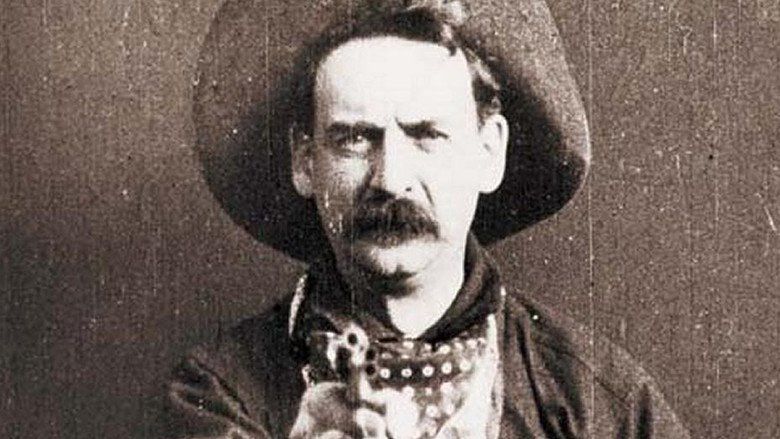The Great Train Robbery (1903 film)
7.6 /10 1 Votes
Screenplay Edwin S. Porter Country United States | 7.4/10 IMDb 100% Rotten Tomatoes Duration | |||||||||||||||||||||||||||||||||
 | ||||||||||||||||||||||||||||||||||
Language SilentEnglish intertitles Release date December 1, 1903 (1903-12-01) Film series The Great Train Robbery Film Series Cast (Head Bandit (Fires at Camera)), Gilbert M. Anderson (Bandit (Shot Passenger)), Frank Hanaway (Bandit), Adam Charles Hayman (Bandit), Mary Snow (Little Girl), Walter Cameron (The Sheriff)Similar movies Cowboys & Aliens , The General , Killing Zoe , Craving Desire , Death Rides a Horse , Drugstore Cowboy | ||||||||||||||||||||||||||||||||||
The great train robbery 1903
The Great Train Robbery is a 1903 American silent short Western film written, produced, and directed by Edwin S. Porter, a former Edison Studios cameraman. Actors in the movie included Alfred C. Abadie, Broncho Billy Anderson and Justus D. Barnes, although there were no credits. Though a Western, it was filmed in Milltown, New Jersey. The film was inspired by Scott Marble's 1896 stage play.
Contents
- The great train robbery 1903
- The great train robbery
- Plot
- Final shot
- Release and reception
- In popular culture
- References

At twelve minutes long, The Great Train Robbery film is considered a milestone in film making, expanding on Porter's previous work Life of an American Fireman. The film used a number of then-unconventional techniques, including composite editing, on-location shooting, and frequent camera movement. The film is one of the earliest to use the technique of cross cutting, in which two scenes are shown to be occurring simultaneously but in different locations. Some prints were also hand colored in certain scenes. Techniques used in The Great Train Robbery were inspired by those used in Frank Mottershaw's British film A Daring Daylight Burglary, released earlier in the year. Film historians now largely consider The Great Train Robbery to be the first American action film and the first Western film with a "recognizable form".
In 1990, The Great Train Robbery was selected for preservation in the United States National Film Registry by the Library of Congress as being "culturally, historically, or aesthetically significant".
The great train robbery
Plot
The film opens with two bandits breaking into a railroad telegraph office, where they force the operator at gunpoint to have a train stopped and to transmit orders for the engineer to fill the locomotive's tender at the station's water tank. They then knock the operator out and tie him up. As the train stops it is boarded by the bandits—now four. Two bandits enter an express car, kill a messenger and open a box of valuables with dynamite; the others kill the fireman and force the engineer to halt the train and disconnect the locomotive. The bandits then force the passengers off the train and rifle them for their belongings. One passenger tries to escape but is instantly shot down. Carrying their loot, the bandits escape in the locomotive, later stopping in a valley where their horses had been left.
Meanwhile, back in the telegraph office, the bound operator awakens, but he collapses again. His daughter arrives bringing him his meal and cuts him free, and restores him to consciousness by dousing him with water.
There is some comic relief at a dance hall, where an Eastern stranger is forced to dance while the locals fire at his feet. The door suddenly opens and the telegraph operator rushes in to tell them of the robbery. The men quickly form a posse, which overtakes the bandits, and in a final shootout kills them all and recovers the stolen mail.
Final shot
An additional scene of the film is a close-up of the leader of the bandits, played by Justus D. Barnes, who empties his pistol point-blank into the camera. Although it is usually placed at the end, Porter stated that the scene could also appear at the beginning of the film.
In the 1990 film Goodfellas, the final shot of Tommy shooting at the camera was based on the shot from this film.
Release and reception
The Great Train Robbery had its official debut at Huber's Museum in New York City before being exhibited at eleven theaters elsewhere in the city. In advertising for the film, Edison agents touted the film as "...absolutely the superior of any moving picture ever made" as well as a "...faithful imitation of the genuine 'Hold Ups' made famous by various outlaw bands in the far West..."
The film's budget was an estimated $150. Upon its release, The Great Train Robbery became a massive success and is considered one of the first Western films. It is also considered one of the first blockbusters and was one of the most popular films of the silent era until the release of The Birth of a Nation in 1915.
In popular culture
References
The Great Train Robbery (1903 film) WikipediaThe Great Train Robbery (1903 film) Rotten TomatoesThe Great Train Robbery (1903 film) IMDb The Great Train Robbery (1903 film) themoviedb.org
